14 Carlsberg
Introduction
Carlsberg “Probably the best beer in the world”

Carlsberg is a Danish Brewery that was establi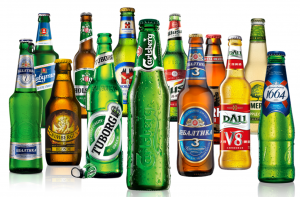 shed in 1847 by the founder, J.C. Jacobsen, who was a philanthropist and an acquisitive art collector. It is one of the world’s largest and most popular brewery for several years. Apart from Carlsberg beer, which is a flagship product, Carlsberg foundation is responsible for several other beer brands that are being sold in over 150 countries around the world. These include, Tuborg; Kronenbourg; Somersby cider; Neptun, Russia’s best-selling beer; Baltika; Belgian Grimbergen; Fix, one of Greece’s oldest brands; and more than 500 local beers.
shed in 1847 by the founder, J.C. Jacobsen, who was a philanthropist and an acquisitive art collector. It is one of the world’s largest and most popular brewery for several years. Apart from Carlsberg beer, which is a flagship product, Carlsberg foundation is responsible for several other beer brands that are being sold in over 150 countries around the world. These include, Tuborg; Kronenbourg; Somersby cider; Neptun, Russia’s best-selling beer; Baltika; Belgian Grimbergen; Fix, one of Greece’s oldest brands; and more than 500 local beers.
Origin
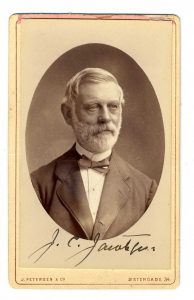
Carlsberg was started by J.C. Jacobsen in 1847 in the streets of Copenhagen, Denmark. J.C. Jacobsen, who was born in 1811, first started brewing larger in his own cellar until he was 36. At this age, he managed to open his own company on a mountain which was a perfect place for the brewery. Jacobsen is a man who believes deeply in science, and is obsessed in art and music. He also shows keen interest in politics and society. All his qualities gave an essence to the company that made it a huge success.
Why is it called Carlsberg? Well, Jacobsen names his company after his son Carl and since the brewery stood on a mountain, he added “Bjerg”, which is a Danish name for “mountain”.
From the first brew in 1847, Carlsberg larger was only distributed to the local citizens. As years passed by, they became very popular in Denmark for their better flavor. So, Jacobsen decided to distribute their products to other countries. Their first export began on 1868 to Edinburg, Scotland.
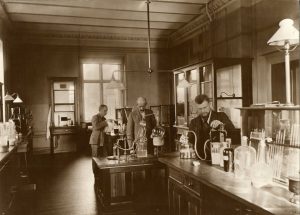
In 1875, J.C. Jacobsen started the first industrial research laboratory for research science and innovation. The main reason behind this is to brew better beer regardless of the money. Many other brewers logged complains that he kept his prices too low. Moreover, the research laboratory had a protocol that anything discovered at the lab will be freely shared. In the next year, J.C. Jacobsen set up the Carlsberg Foundation which managed the Carlsberg laboratory and also promotes arts, science and culture even today.
Son of Jacobsen, Carl Jacobsen, was passionate about beer just like his father. He spent several years
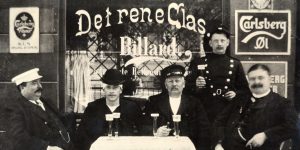
in France, Germany, Australia and Scotland for his education, where he gained a good knowledge of beer on his return to home. He then set up a brewery of his own in competition to his father in the year 1882. He named it as the Ny (or New) Carlsberg forcing J.C. Jacobsen to name his company as Gamle (or Old) Carlsberg. Later on in the year 1906, both the Ny and Gamle Carlsberg reunited under the Carlsberg Foundation and Carl officially became the first managing director of the brewery.
Back then, brewers were re-using beer from previous fermentation which resulted in the
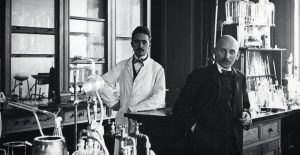
contamination of wild yeast, till 1883, where a researcher at Carlsberg laboratory, named Emil C. Hansen, discovered a method of isolating yeast so that brewers could use fresh yeast during every fermentation. This yeast was named as Saccharomyces Carlsbergensis and it was distributed freely to anyone including other brewers until 1988. This changed the entire production of beer globally. Apart from the yeast, Carlsberg foundation also discovered the pH scale which became an international system of measuring the hydrogen ion levels in solutions.
Key Milestones
- J.C. Jacobsen founded the Carlsberg brewery in 1847, which was named after his son.
- The export of Carlsberg beer began in 1868.
- Carl Jacobsen started a separate company named the Ny Carlsberg in competition to his father in 1882. This caused a huge conflict between them.
- J.C. Jacobsen built a laboratory in the year 1875.
- In the following year, he established the Carlsberg foundation to manage the Carlsberg laboratory and support scientific researches.
- In 1883, Carlsberg Laboratory discovered a method of producing fresh yeast so that re-using beer from previous fermentation could be avoided. This idea was shared to all the other brewers.
- In 1906, both father’s and son’s companies merged together under the Carlsberg foundation making Carl Jacobsen the first managing director of Carlsberg.
- Carlsberg obtained it first overseas license in 1966 and brewed at the Photiades Breweries in Cyprus.
- Later on, in 1968 Carlsberg built their first brewery outside Denmark in Blantyre, Malawi.
- The United Breweries AS was formed when Carlsberg and Tuborg merged together in 1970.
- Afterwards in 1992, Carlsberg merged with Tetley and eventually gained the ownership in 1997.
- Carlsberg partners with Heineken bought the Scottish & Newcastle brewery in UK for 15.3 billion dollars.
- In 2014, Carlsberg took over the Olympic Breweries, which is one of the largest breweries in Greece.
Brewing science and industrialization
The science behind the production of beer changed the entire brewing process of Carlsberg that gave its qual
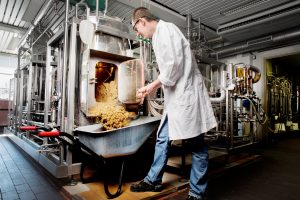
ity, essence and taste to be at its top notch. The first most important factor that had a large impact on the growth of beer is the development of appropriate equipment and technology that urged scientists to research and study on the science behind beer. This led to the discoveries in the fermentation process one by one. These include, the method of extracting hops, the method of measuring and controlling the conversion of sugar to ethanol, derivation of the chemical formulas, discovery of enzymes and yeast, difference between aerobic and anaerobic respiration and many more.
Until 1883, brewers were using yeast developed by L. Pasteur’s concept, which is separating the bacteria from the yeast. Later, in 1983, C.E. Hansen, who was a skilled researcher at the Carlsberg laboratory, discovered that yeast contains three different species where the other two are called wild yeast. Then he found a way to remove the wild yeast so that yeast was purified for better and safe fermentation. This pure yeast was distributed to whoever was in need of it. This discovery changed the entire brewing process of beer not only at Carlsberg but also at all the brewery industries.
Apart from the brewery science, discoveries from other disciplines such as packaging, manufacturing, trans
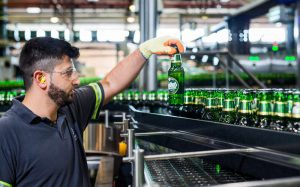
porting, storing, environmental quality and sustainability also had a huge impact on the development of the beer. The production of glass bottles supported Carlsberg foundation in their long-distance transportation, but when the prices of these bottles rose, the foundation struggled for a solution. This is when trains and steamboats played their part with their improved steam engines. This reduced the cost of transportation that helped Carlsberg foundation to not lose their sales. Later, larger beer was packaged in cans and kegs mainly to reduce the number of materials used. Though, the beer containers were developed in an optimized design, engineers were always concerned to ensure the beer stays delicious and at the same time cold.
Beer Style
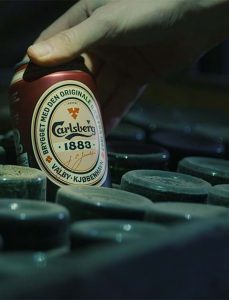
The color of Carlsberg beer looks similar to the color of dazzling color of copper with a closely and neatly packed head. The taste of the beer has been reviewed to be unique and distinct with an aroma that gives a delicate hint of malt and caramel. Similar to other beers, the ingredients use by Carlsberg are water, barley malt, rice, hops, and yeast. “Then from where does Carlsberg gets its unique taste?” You might ask. This is achieved by providing the proper proportions of quality ingredients in the brewery process. For Carlsberg, three different types of malts are used which adds the varying sweetness to the beer. This includes the Munich malt, caramel malt and roasted malt. The hops used for this beer is the Hallertauer hops is a German hop that looks like a flower, has a mild aroma and also has a spicy and a little bit of fruit like taste. The pure yeast is the ingredient that makes the beer alcoholic and gives its effervescent. This culture of pure yeast rapidly decreased the spoilage in brewing. The alcohol by volume for Carlsberg beers is different from their product to product as they are involved in the production of several beers. The Carlsberg Danish Pilsner has 3.8% ABV and the Carlsberg Export has 4.8 % ABV.
The WWI and WWII era
The World War I and II were the tough times for the entire world as people all around the world suffered a lot.  The Danes were one of them. Not only the beer industry but also all the other industries were at stake during these times. During the world war I, which was from 1914 to 1918, Carlsberg had to face several challenges. The production of beer fell by greater amounts due to scarcity of the raw materials required for the production of beer. The export of beer was restricted and the consumption of alcohol was being protested at that time. These factors halted the growth of the beer industries. During the period between the two wars, the sales gradually rose but never to its state before the war.
The Danes were one of them. Not only the beer industry but also all the other industries were at stake during these times. During the world war I, which was from 1914 to 1918, Carlsberg had to face several challenges. The production of beer fell by greater amounts due to scarcity of the raw materials required for the production of beer. The export of beer was restricted and the consumption of alcohol was being protested at that time. These factors halted the growth of the beer industries. During the period between the two wars, the sales gradually rose but never to its state before the war.
Again, during the World War II, that happened between 1935 to 1945, Carlsberg industry fell due to the scarcity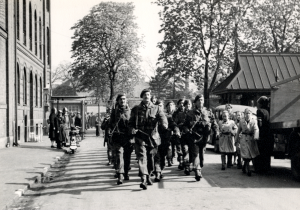 of raw materials, influence of the German empire and the pressure of the war. Exports were only allowed into Germany and at the same time, the sales were low because Germans hesitated to consume alcohol during their service.
of raw materials, influence of the German empire and the pressure of the war. Exports were only allowed into Germany and at the same time, the sales were low because Germans hesitated to consume alcohol during their service.
After the war, Carlsberg along with Tuborg and Heineken resumed their export to other countries, which they mainly focused on United Kingdom as their major recipient. This gradually increased the trade and Carlsberg started to open new breweries abroad. However, due to the impact of war, Carlsberg took several years to flourish in the market again.
Consolidation and Globalization
The headquarters of Carlsberg is In Copenhagen, Denmark. Carlsberg firm is the most dominant firm in the Eastern Europe and has a powerful position in the Western Europe. 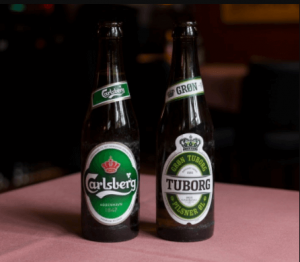 Carlsberg and Tuborg are the brands that are globally recognized, but still, they are the least global firm out of the four firms. The Carlsberg companies’ markets are divided to Western Europe, Eastern Europe and Asia. They do not focus much on Africa or America. The company owns two brands in Russia: San Miguel and Baltic Beverage Holdings. The firm has also bought breweries in other countries such as Latvia, Poland and China. Until the recent years, Carlsberg was managed by a foundation, which put it at a downfall for financing acquisitions. Therefore, if there were any further consolidations in the industry, Carlsberg might become the most vulnerable to take over.
Carlsberg and Tuborg are the brands that are globally recognized, but still, they are the least global firm out of the four firms. The Carlsberg companies’ markets are divided to Western Europe, Eastern Europe and Asia. They do not focus much on Africa or America. The company owns two brands in Russia: San Miguel and Baltic Beverage Holdings. The firm has also bought breweries in other countries such as Latvia, Poland and China. Until the recent years, Carlsberg was managed by a foundation, which put it at a downfall for financing acquisitions. Therefore, if there were any further consolidations in the industry, Carlsberg might become the most vulnerable to take over.
Marketing and Branding
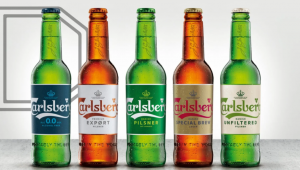 Carlsberg group is one of the leading brewing companies since 1847. Stepping into more than 170 years of history the demand for the alcoholic and non-alcoholic is extensive in both Asian & European market. Despite of the number of years to build and brand name, Carlsberg beer is standing out uniquely because the branding entirely depends on how memorable the beer is!
Carlsberg group is one of the leading brewing companies since 1847. Stepping into more than 170 years of history the demand for the alcoholic and non-alcoholic is extensive in both Asian & European market. Despite of the number of years to build and brand name, Carlsberg beer is standing out uniquely because the branding entirely depends on how memorable the beer is!
Rather than advertising in formal ways. Carlsberg company has adapted its own ways to use modern marketing strategies. Digital transformation of marketing of Carlsberg has made the Carlsberg name to be the most talked beer brand in social media. The Danish brewer sets up contents in social networks such as Facebook, Twitter & google+ for all its 500 brands. The campaigns launched a platform that allows its marketers to create and distribute content to social networks including Facebook, Google+ and Twitter for all 500 of its brands.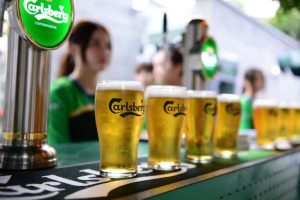
The campaigns were monitored in real time and as a result the existing Carlsberg lovers were more enthusiastic and the new customers had come to expect more taste and more quality from a pint. This paves the way to re brew Carlsberg Danish Pilsner – a new dawn for Carlsberg brand. Moreover, upon the ban of liquor branding in India Carlsberg has adapted a smooth flow of surrogate advertising. In this scenario, Carlsberg has its innovative ideas in advertising Carlsberg Club glasses, Carlsberg meeting room, Tuborg zero soda, Tuborg beat, Seagram’s Imperial Blue music CDs and lots to create a better position in consumer minds.
Modern Era
The new approach towards setting sail in increased sales Carlsberg has concentrated on more innovative Marketing Strategic plans. In order to boost the sales after the post 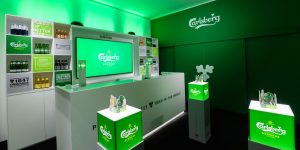 pandemic the company has launched the £15m Carlsberg Export rebrand, which included a new marketing campaign and product redesign, last year. Strong marketing is a requirement for maintaining and preferably increasing market share, various brands are sold worldwide through multi-mode delivery like distribution partnership with the subsidiaries, strategic partners, competitors, local distributors, retailers, e-commerce sites and wholesalers. Rather than making majority of investments in tv the Carlsberg also created awareness among the youth via social media campaigns. Carlsberg signed up to RE100 platform, which is organized by the Climate Group which encouraged the innovations such as green fiber bottle and designing of snap pack for minimal plastic usage. These innovations ensured the cutting down of Carbon as per agreement made.
pandemic the company has launched the £15m Carlsberg Export rebrand, which included a new marketing campaign and product redesign, last year. Strong marketing is a requirement for maintaining and preferably increasing market share, various brands are sold worldwide through multi-mode delivery like distribution partnership with the subsidiaries, strategic partners, competitors, local distributors, retailers, e-commerce sites and wholesalers. Rather than making majority of investments in tv the Carlsberg also created awareness among the youth via social media campaigns. Carlsberg signed up to RE100 platform, which is organized by the Climate Group which encouraged the innovations such as green fiber bottle and designing of snap pack for minimal plastic usage. These innovations ensured the cutting down of Carbon as per agreement made.
References
- About the. (n.d.). Carlsberg Group. https://www.carlsberggroup.com/who-we-are/about-the-carlsberg-group/
- Beer, G. I. (2014, August 8). Gluten in Beer: Carlsberg. Gluten in Beer. http://gluteninbeer.blogspot.com/2014/08/carlsberg.html
- C. (2021, June 18). Carlsberg. CompaniesHistory.Com – The Largest Companies and Brands in the World. https://www.companieshistory.com/carlsberg/
- Cabras, I., & Higgins, D. M. (2016). Beer, brewing, and business history. Business History, 58(5), 609–624. https://doi.org/10.1080/00076791.2015.1122713
- Carlsberg 1883 | Rebrew – Carlsberg. (n.d.). Www.carlsberg.com. Retrieved March 13, 2022, from https://www.carlsberg.com/en/our-beer/1883/
- Denmark. (n.d.). Carlsberg Group. https://www.carlsberggroup.com/who-we-are/about-the-carlsberg-group/global-presence/denmark/
- Global Presence. (n.d.). Carlsberg Group. https://www.carlsberggroup.com/who-we-are/about-the-carlsberg-group/global-presence/
- Newsroom» BLOG: Historic pictures show VE celebrations at Carlsberg in Copenhagen as British troops toast to the end of World War II «Carlsberg Marston’s Brewing Company. (n.d.). Carlsberg Marston’s Brewing Company. Retrieved March 13, 2022, from https://www.carlsbergmarstons.co.uk/newsroom/blog-historic-pictures-show-ve-celebrations-at-carlsberg-in-copenhagen-as-british-troops-toast-to-the-end-of-world-war-ii/
- Poulsen, B. (2016). Carlsberg appreciation. In brill.com. Brill. https://brill.com/view/book/9789004316393/B9789004316393-s010.xml
- Products. (n.d.). Carlsberg Group. https://www.carlsberggroup.com/products/
- https://www.carlsberg.com/pioneers/j-c-jacobsen/
- https://www.carlsberg.com/pioneers/carl-jacobsen/
- https://www.carlsberg.com/pioneers/emil-c-hansen/
- https://www.carlsberg.com/pioneers/soeren-pl-soerensen/
- Who we are» Groundbreaking Research» Brewing Science & Technology «Carlsberg Group. (n.d.). Carlsberg Group. https://www.carlsberggroup.com/who-we-are/groundbreaking-research/brewing-science-technology/
- Who we are» Groundbreaking Research» New Ingredients «Carlsberg Group. (n.d.). Carlsberg Group. https://www.carlsberggroup.com/who-we-are/groundbreaking-research/new-ingredients/
- Who we are» Groundbreaking Research» Raw Materials «Carlsberg Group. (n.d.). Carlsberg Group. https://www.carlsberggroup.com/who-we-are/groundbreaking-research/raw-materials/
- Who we are» Groundbreaking Research» Yeast & Fermentation «Carlsberg Group. (n.d.). Carlsberg Group. https://www.carlsberggroup.com/who-we-are/groundbreaking-research/yeast-fermentation/
- Wikipedia contributors. (2021, December 5). Carlsberg Group. Wikipedia. https://en.wikipedia.org/wiki/Carlsberg_Group

